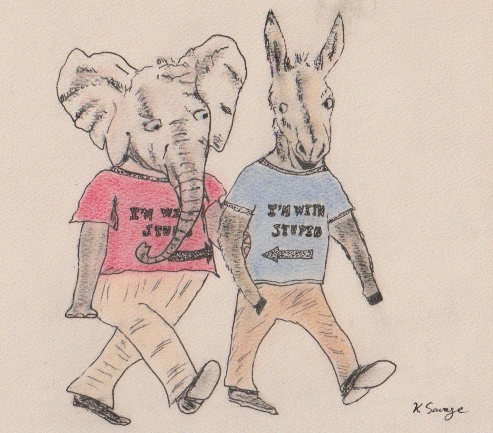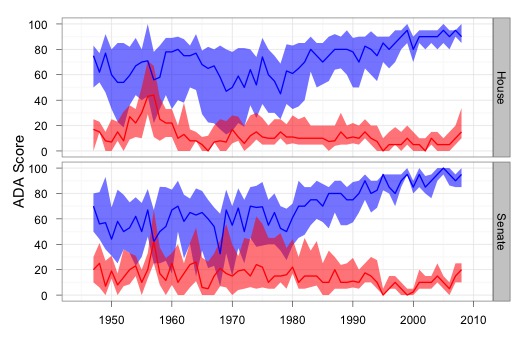The Polarization of Political Parties

Washington has never been more partisan, right? Or is that common lament simply a trick of nostalgia? A look at the numbers reveals that the problem is not, it turns out, all in our heads: over the last four decades, Congressional polarization has steadily increased.
“Not only have the Democratic and Republican parties drifted apart, but they have become much more internally homogeneous.”
Since 1947, Americans for Democratic Action (ADA) has tracked the political positions of each Senate and House member, scoring how they voted each year on 20 key bills covering a variety of social and economic issues. A score of 90%, for example, indicates a Congressman took the liberal position (as judged by the ADA) on 18 of the 20 votes, while a score of 10% means they did so on just 2 of the 20 bills. The graph below shows a disconcerting rise in polarization over the last 40 years, with the colored bands indicating where the middle 50% of each party ranks. Not only have the Democratic and Republican parties drifted apart in the last 40 years, but they have also become much more internally homogeneous.

Curious how you stack up against Congress? Here are five of the twenty legislative issues that the ADA used to rank Senators in 2010. How many of these bills would you support?
- Increase regulation of Wall Street (The Dodd-Frank Wall Street Reform and Consumer Protection Act)
- Require that the President present a timetable for withdrawal from Afghanistan.
- Allow the Environmental Protection Agency (EPA) to continue regulating greenhouse gas emissions from factories, power plants and other large polluters.
- Let the Food and Drug Administration (FDA) directly recall tainted products, rather than rely on manufacturers’ voluntary cooperation
- Allow openly gay individuals to serve in the military
5 out of 5: You may want to consider moving
to Vermont, home of two of the most liberal Senators, Bernie
Sanders and Patrick Leahy.
4 out of 5:
You’re a party-line Democrat. John Kerry is your man.
3 out of 5: Swing voter? You’re of
like mind with Joe Lieberman, the former Democratic
vice-presidential hopeful who in 2008 turned his support to
Republican presidential nominee John McCain
2 out of 5: You’re a “maverick”, a la John McCain circa
2001
1 out of 5: You’re in
Congressional no-man’s land, with Indiana Republican Dick
Lugar one of your only compatriots
0 out of 5: You’re a party-line Republican, like Nebraska
Senator-turned-Governor Sam Brownback, or the new John McCain as
of 2010. You probably don’t like either tofu or Volvos.
In this era of sectarian politics, it’s easy to forget that Democrats and Republicans have not always been so rigidly ideological. While that quaint idea of post-partisan governing likely won’t come to fruition anytime soon, history at least offers some hope for less political fanaticism.
ADA data collected by Timothy Groseclose. See “Comparing Interest Group Scores Across Time and Chambers: Adjusted ADA Scores for the U.S. Congress,” by Tim Groseclose, Steven D. Levitt, and James M. Snyder, Jr.
Illustration by Kelly Savage. Thanks to David Pennock, David Rothschild, and Dan Reeves for comments.
